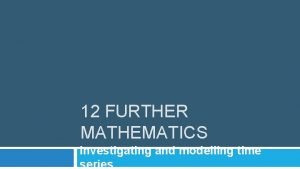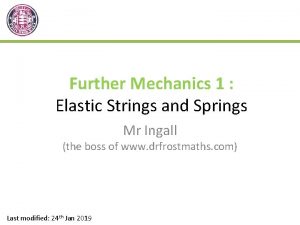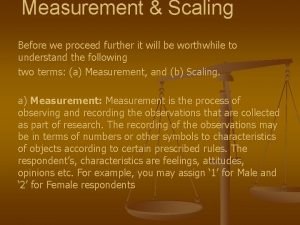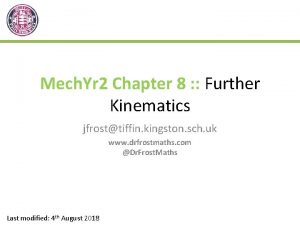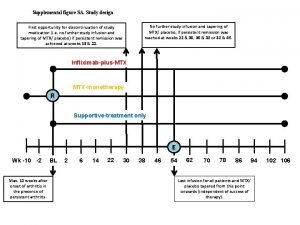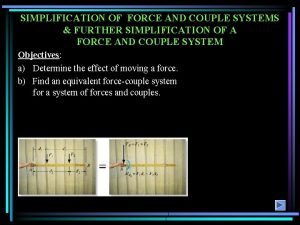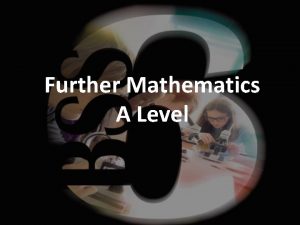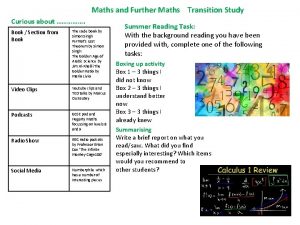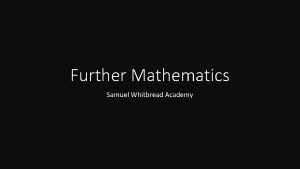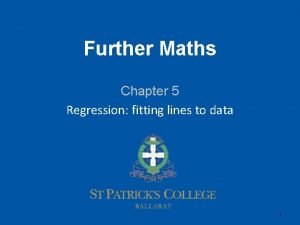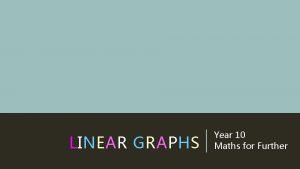L 6 FM 1 Further Maths DiscreteDecision Maths























- Slides: 23

L 6 FM 1 Further Maths Discrete/Decision Maths Dr Cooper (NSC)

Graph Theory

Graph Theory

Graph Theory


Biochemical Networks


Graph Theory A graph (network) is a collection of nodes (also called vertices, shown by blobs) connected by arcs (or edges or legs, shown by straight or curved lines)

Graph Theory A graph (network) is a collection of nodes (also called vertices, shown by blobs) connected by arcs (or edges or legs, shown by straight or curved lines) Graphs can used to represent oil flow in pipes, traffic flow on motorways, transport of pollution by rivers, groundwater movement of contamination, biochemical pathways, the underground network, etc

Graph Theory Simple graphs do not have loops or multiple arcs between pairs of nodes. Most networks in D 1 are Simple graphs.

Graph Theory Simple graphs do not have loops or multiple arcs between pairs of nodes. Most networks in D 1 are Simple graphs.

Graph Theory A complete graphs is one in which every node is connected to every other node. The notation for the complete graph with n nods is Kn K 4

Graph Theory A subgraph can be formed by removing arcs and/or nodes from another graph. Graph Subgraph

Graph Theory A bipartite graph is a graph in which there are 2 sets of nodes. There are no arcs within either set of nodes.

Graph Theory A complete bipartite graph is a bipartite graph in which …

Graph Theory A complete bipartite graph is a bipartite graph in which every node in one set is connected to every node in the other set

Graph Theory The order of a node is the number of arcs meeting at that node. In the subgraph shown, A and F have order 2, B and C have order 3 and D has order 4. A, D and F have even order, B and C odd order. Since every arc adds 2 to the total order of all the nodes, this total is always even. B A C D F

Graph Theory B A connected graph is one for which a path can be found between A any two nodes. C D X The illustrated graph is NOT connected. Z Y F

Graph Theory An Eulerian Graph has every node of even order. Euler proved that this was identical to there being a closed trail containing every arc precisely once. e. g. BECFDABCDB E B A C D F

Graph Theory A semi-Eulerian Graph has exactly two nodes of odd order. Such graphs contain a non-closed trail containing every arc precisely once. B A C D F

Graph Theory A semi-Eulerian Graph has exactly two nodes of odd order. Such graphs contain a non-closed trail containing every arc precisely once. Such a trail must start at one odd node and finish at the other. e. g. BADBCDFC B A C D F

Konigsberg Bridges

Konigsberg Bridges
 Time series further maths
Time series further maths Tension in elastic string
Tension in elastic string Life is a highway metaphor
Life is a highway metaphor A ship’s compartment corresponds to a room in a building
A ship’s compartment corresponds to a room in a building Further education support service
Further education support service Sell or process further decision
Sell or process further decision Further applications of integration
Further applications of integration Itemised rating scale
Itemised rating scale English for further studies
English for further studies Dr frost further kinematics
Dr frost further kinematics For details please contact
For details please contact Further mechanics 1 unit test 1 momentum and impulse
Further mechanics 1 unit test 1 momentum and impulse Further applications of integration
Further applications of integration Further applications of integration
Further applications of integration Cohesion
Cohesion Further applications of integration
Further applications of integration Not for further distribution
Not for further distribution For further information please visit
For further information please visit Havering college of further and higher education
Havering college of further and higher education Further applications of integration
Further applications of integration Further study design
Further study design Simplification of a force and couple system
Simplification of a force and couple system Letter requesting for information
Letter requesting for information This is to certify further
This is to certify further
